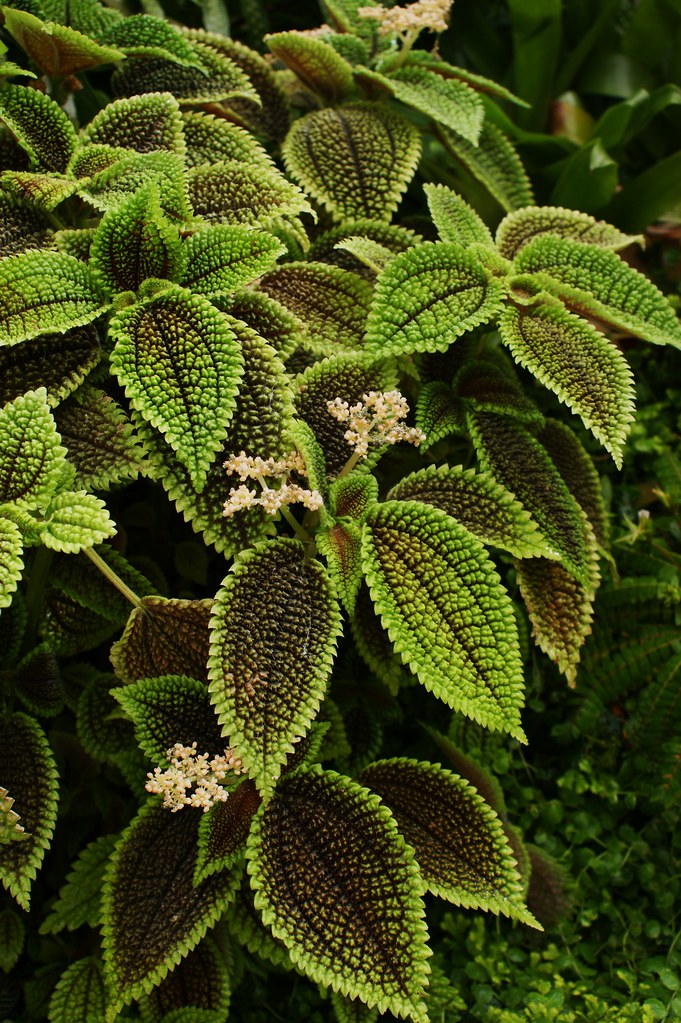Article-at-a-Glance
- The Friendship Plant (Pilea involucrata) is non-toxic to pets, making it a safe choice for homes with animals.
- This plant thrives in bright, indirect light but can adapt to low light conditions.
- Water the Friendship Plant when the top inch of soil feels dry to prevent overwatering.
- Ideal for terrariums, it requires high humidity and warm temperatures between 65°F to 75°F (18°C to 24°C).
- Propagation is easy through stem cuttings, making it a great plant to share with friends.
Identifying the Friendship Plant
The Friendship Plant, scientifically known as Pilea involucrata, is a charming addition to any indoor garden. It is known for its lush, textured leaves that create a striking appearance. With its compact size, it fits perfectly on windowsills or as part of a larger plant collection.
“Pilea involucrata – Friendship plant …” from travaldo.blogspot.com and used with no modifications.
Key Characteristics and Appearance
This plant boasts small, oval leaves with a deeply quilted texture, giving it a unique and appealing look. The leaves are typically a vibrant green, often with a hint of bronze or purple, depending on the light conditions. This variation in color adds an extra layer of beauty, making the Friendship Plant a favorite among plant enthusiasts.
Natural Habitat and Origin
Originally hailing from Central and South America, the Friendship Plant thrives in the humid, tropical environments of these regions. It naturally grows on the forest floor, where it receives dappled sunlight filtered through the canopy above. Understanding its natural habitat helps in recreating similar conditions at home, ensuring the plant’s health and vitality.
Common Varieties
While Pilea involucrata is the most recognized variety, there are several other types worth mentioning. Each offers its unique twist on the classic Friendship Plant appearance:
- Pilea ‘Moon Valley’: Known for its crinkled leaves with a metallic sheen.
- Pilea ‘Norfolk’: Features more elongated leaves with a soft texture.
- Pilea ‘Silver Tree’: Distinguished by its silvery leaf markings.
Care Guide for Friendship Plant
Caring for a Friendship Plant is straightforward, making it an excellent choice for both beginners and seasoned gardeners. With the right conditions, this plant will flourish and become a centerpiece of your indoor garden.
Ideal Soil and Potting Mix
The Friendship Plant prefers well-draining soil to prevent waterlogging and root rot. A potting mix specifically designed for houseplants or one that includes peat moss, perlite, and vermiculite is ideal. This combination retains moisture without becoming overly saturated. For those interested in enhancing their plant care routine, exploring pet aromatherapy benefits can provide additional insights into creating a calming environment for both plants and pets.
Watering Schedule and Tips
Watering is crucial for the health of your Friendship Plant. Allow the top inch of soil to dry out before watering again. This usually means watering once a week, but it can vary depending on the climate and season. Always ensure excess water can drain away to avoid root rot.
Temperature and Humidity Preferences
Originating from tropical regions, the Friendship Plant thrives in warm temperatures between 65°F to 75°F (18°C to 24°C). It dislikes cold drafts, so keep it away from open windows during winter. High humidity levels, around 60-90%, mimic its natural environment and promote healthy growth.
Lighting Requirements
Proper lighting is essential for the vibrant growth of your Friendship Plant. While it can tolerate lower light conditions, providing the right amount of light will ensure it maintains its lush appearance.
Place your plant in a spot where it receives bright, indirect light. A north or east-facing window is often ideal. If natural light is limited, consider using artificial grow lights to supplement its needs. Avoid direct sunlight as it can scorch the leaves, leading to unsightly damage.
Optimal Light Conditions
The Friendship Plant thrives best in bright, indirect light, which helps maintain its vibrant leaf color and healthy growth. Think of it as a plant that enjoys the morning sun but needs a break from the harsh afternoon rays. Positioning it near a north or east-facing window can provide the perfect balance of light exposure.
Effects of Direct Sunlight and Shade
Direct sunlight can be too intense for the Friendship Plant, causing leaf burn and discoloration. If you notice the leaves turning brown or crispy, it’s a sign that the plant is receiving too much direct light. On the flip side, while the plant can tolerate low light conditions, it may result in slower growth and less vibrant foliage. For those interested in creating a harmonious living space, consider exploring pet-friendly furniture to complement your indoor greenery.
“A friend of mine placed her Friendship Plant in a west-facing window. It thrived during the morning but suffered in the afternoon sun. A simple move to an east-facing window brought it back to life, showing how adaptable and forgiving these plants can be when given the right conditions.”
If your plant is in a shaded area and seems lackluster, try moving it closer to a light source. Alternatively, supplementing with artificial light can also help, especially in spaces with limited natural light.
Flowering and Growth Patterns
While the Friendship Plant is primarily grown for its attractive foliage, it can produce small, inconspicuous flowers. These flowers are not the main attraction, but they add a charming touch to the plant’s overall appearance.
The plant grows in a compact, bushy form, making it an excellent choice for small spaces. It typically reaches a height of 6-12 inches and can spread up to 18 inches wide. Regular pruning can help maintain its shape and encourage bushier growth.
Flowering Characteristics
The flowers of the Friendship Plant are small and often go unnoticed. They usually appear during the spring and summer months. If you do spot them, consider it a bonus to the already beautiful foliage. The plant’s primary appeal lies in its leaves, which can vary in color and texture based on light exposure and growing conditions. For those interested in enhancing their indoor garden, pet aromatherapy can be a safe and calming addition to your plant care routine.
Growth Behavior and Lifecycle
The Friendship Plant is a perennial, meaning it can live for several years with proper care. It has a slow to moderate growth rate, making it easy to manage indoors. Regularly check for new growth at the base of the plant, as this indicates a healthy and thriving specimen.
To encourage continued growth, consider repotting every 1-2 years. This refreshes the soil and provides more room for the roots to expand. Choose a pot that is only slightly larger than the current one to prevent overwatering issues.
“Pilea involucrata (Friendship Plant …” from plants.ces.ncsu.edu and used with no modifications.
Use in Terrariums
Friendship Plants are excellent candidates for terrariums due to their compact size and love for humidity. Terrariums provide a controlled environment that mimics the plant’s natural habitat, offering both aesthetic and functional benefits.
Benefits of Incorporating in Terrariums
Incorporating the Friendship Plant into a terrarium setup enhances the visual appeal of your indoor garden. The enclosed space maintains higher humidity levels, which the plant loves. Additionally, terrariums offer protection from pests and environmental stressors, promoting healthier growth.
Creating an Ideal Terrarium Environment
To set up a terrarium for your Friendship Plant, start with a clean glass container. Add a layer of small pebbles or gravel for drainage, followed by a layer of activated charcoal to keep the environment fresh. Next, add a layer of well-draining potting mix suitable for houseplants.
Position the plant in the center, ensuring it has enough space to grow. Decorate with moss or small stones to create a natural look. Place the terrarium in a location with bright, indirect light, and monitor the moisture levels to prevent overwatering.
Propagation Techniques
Propagating the Friendship Plant is a rewarding process that allows you to expand your collection or share with friends. The most effective method is through stem cuttings, which are easy to root and grow.
Start by selecting a healthy stem with several leaves. Using clean scissors, cut just below a node (the point where leaves attach to the stem). Remove the lower leaves to expose the node and place the cutting in a glass of water or directly into moist potting mix. Keep it in a warm, bright location, and roots should develop within a few weeks.
Step-by-Step Propagation from Cuttings
Propagating your Friendship Plant is a simple and fulfilling way to multiply your greenery. Begin by selecting a healthy stem with several leaves attached. With clean scissors, cut the stem just below a node, which is the point where leaves grow from the stem. This is crucial because the node is where new roots will develop.
Once you have your cutting, remove the lower leaves to expose the node. You can choose to place the cutting in a glass of water or directly into a pot with moist potting mix. If using water, ensure the node is submerged and change the water every few days to keep it fresh. If planting directly in soil, keep the soil consistently moist but not soggy.
Place the cutting in a warm area with bright, indirect light. Within a few weeks, you should see roots forming. Once the roots are a few inches long, the cutting is ready to be potted into its new home.
Encouraging Healthy New Growth
After successful propagation, focus on encouraging healthy growth in your new plant. Start by providing it with optimal light conditions, as light plays a significant role in the plant’s development. Remember, bright, indirect light is ideal. For more detailed care tips, check out this Friendship Plant care guide.
Consistent watering is also key. Monitor the soil moisture regularly, allowing the top inch to dry out before watering again. This prevents overwatering, which can be detrimental to new plants.
Fertilizing can also boost growth, but it’s best to wait until the plant is well-established, typically after a few months. Use a balanced, water-soluble fertilizer every few weeks during the growing season to provide essential nutrients.
Toxicity and Compatibility with Pets
One of the many reasons the Friendship Plant is popular among indoor gardeners is its non-toxic nature. It’s safe for homes with pets, ensuring that curious cats or dogs won’t suffer any ill effects if they decide to take a nibble.
Safety for Cats, Dogs, and Other Pets
The Friendship Plant is non-toxic to cats, dogs, and other common household pets. This makes it a safe choice for pet owners who want to enjoy the beauty of indoor plants without worrying about their furry friends’ safety. While it’s always best to discourage pets from eating plants, you can rest easy knowing this plant won’t harm them. For more tips on keeping your pets safe and happy, consider these smart home devices for pet care.
Compatibility with Other Houseplants
Friendship Plants are quite amiable and can coexist well with other houseplants. Their compact size and non-invasive nature make them ideal companions in mixed plant displays or terrariums. When pairing them with other plants, consider those with similar light and humidity needs to ensure a harmonious environment.
Frequently Asked Questions
To help you care for your Friendship Plant, here are some common questions and their answers.
How often should I water my Friendship Plant?
Watering frequency depends on several factors, including light exposure, temperature, and humidity. Generally, you should water your Friendship Plant when the top inch of soil feels dry. This usually means once a week, but it can vary. During warmer months, you might need to water more frequently, while in cooler months, less often.
- Check soil moisture regularly.
- Ensure proper drainage to avoid root rot.
- Adjust watering based on seasonal changes.
Monitoring your plant’s condition will guide you in adjusting your watering routine as needed.
Remember, it’s better to underwater slightly than to overwater, as the latter can lead to root rot.
Can Friendship Plants thrive in low light?
Yes, Friendship Plants can tolerate low light conditions, although they thrive best in bright, indirect light. In lower light, you might notice slower growth and less vibrant foliage. To compensate, you can move the plant closer to a light source or use artificial grow lights to supplement natural light.
What are common pests affecting the Friendship Plant?
While the Friendship Plant is generally hardy, it can occasionally fall prey to common houseplant pests such as spider mites, aphids, and mealybugs. Regularly inspect your plant for signs of infestation, such as discolored leaves or webbing.
If you notice pests, treat them promptly using insecticidal soap or neem oil. Consistent care and maintaining optimal humidity levels can also help prevent pest issues.







